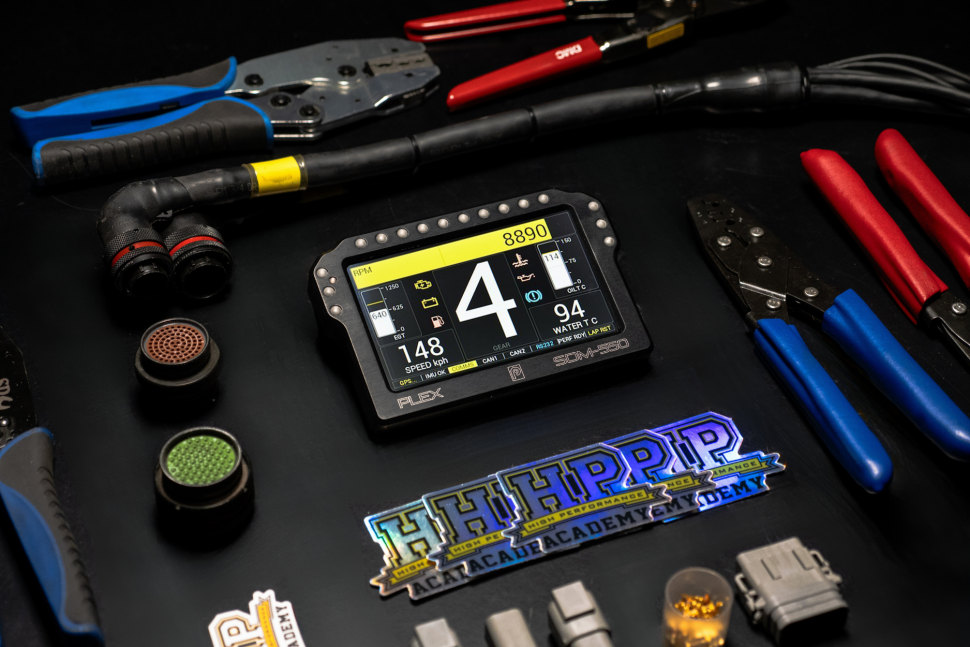| 00:00 |
We can start by looking at how to configure the data logging to suit our requirements.
|
| 00:06 |
This can be achieved from the ‘Edit Data Logging’ window which can be found in the ‘Tools’ menu.
|
| 00:12 |
Immediately we can see the eight available log sets displayed as tabs across the top of the window.
|
| 00:18 |
If you have Level One or Level Two logging, only the ‘Normal’ log set will be available.
|
| 00:24 |
If you have ‘Level Three’ logging, you can enable as many of the eight log sets as you like.
|
| 00:30 |
These can be used to separate your logging into relevant areas.
|
| 00:34 |
For example you may choose to use one log set for engine tuning data and another log set for chassis data.
|
| 00:41 |
The logging system is flexible here and you can set it up to suit your preference.
|
| 00:47 |
Within each log set there is a condition box which defines when the ECU will datalog, and in this case it will log when the ‘Logging Request’ is active.
|
| 00:56 |
If we close the logging window back down and type ‘Logging’ into the ‘All Calibrate’ search box, we can see the conditions that need to be true for the logging to become active.
|
| 01:06 |
We can set an engine rpm and a throttle position which must be exceeded for the logging to start.
|
| 01:13 |
The logging delay is the length of time the logging will remain active after the engine speed or throttle pedal position fall below the activation thresholds.
|
| 01:23 |
Each of the log sets includes a full channel list and we can navigate through this list by either scrolling or using the search bar function.
|
| 01:33 |
The channel list can be displayed as a complete list or in a tree form.
|
| 01:38 |
With so many potential channels though, using the search box is the most common way of finding what you are looking for.
|
| 01:44 |
M1 makes this easy as well since the channel names are very specific and descriptive.
|
| 01:51 |
On the right hand side of the window we have the different logging speeds available.
|
| 01:56 |
We can simply find the channel we want to log and then drag it from the left and drop it onto the appropriate logging speed.
|
| 02:03 |
Alternatively we can use the arrows here to add or remove logged items from the list.
|
| 02:09 |
To speed up the configuration, we can also highlight and add a group of channels simultaneously.
|
| 02:15 |
Just find the channels you want and highlight them by holding down the shift key and using the up or down arrow keys.
|
| 02:22 |
Now you can drag the highlighted list and drop it onto the appropriate logging frequency.
|
| 02:27 |
If you are unsure about what rate to log a certain channel, you can right click and select ‘Auto Schedule’ which will log the channel at its best predetermined logging rate.
|
| 02:38 |
The number of currently logged channels will be displayed here for reference, and at the bottom of the window you can see a ‘Total Channel Count’ bar that will give you a visual representation of how many of your available channels you are currently using.
|
| 02:52 |
We also have a ‘Total Throughput’ bar which you can think of as a measure of the logging bandwidth.
|
| 02:58 |
If you start logging a lot of channels at very high logging rates, you will exceed the available bandwidth and ‘Total Throughput’ will turn red to indicate a problem with your configuration.
|
| 03:10 |
There is also a bar for ‘Total Memory Allocation’ which is not overly relevant if you have level one or two logging.
|
| 03:17 |
If you have level three logging, this will give a representation of how the memory is split among your different log sets.
|
| 03:24 |
Within each log set you can also choose under properties to tick the reserve box and specify a percent of the memory to reserve for the particular log set.
|
| 03:34 |
This ensures a specific amount of logging memory will be made available.
|
| 03:39 |
We also have two other tick boxes here that are important.
|
| 03:44 |
‘Cycle Memory’ will let the logging system overwrite old data once the logging memory is full.
|
| 03:50 |
If this is left unchecked, the ECU will simply stop logging once the memory allocated to the particular log set is full.
|
| 03:57 |
‘Include ECU Messages’ will add some diagnostic message data to the log set that can be useful to the engineers at Motec in diagnosing problems.
|
| 04:07 |
In general you should leave this box ticked.
|
| 04:12 |
If we click on the ‘Summary’ tab, we can see a summary of which log sets are being used, how they are triggered, what their memory allocation is, and finally what the estimated logging time will be based on the number of logged channels and their frequency.
|





